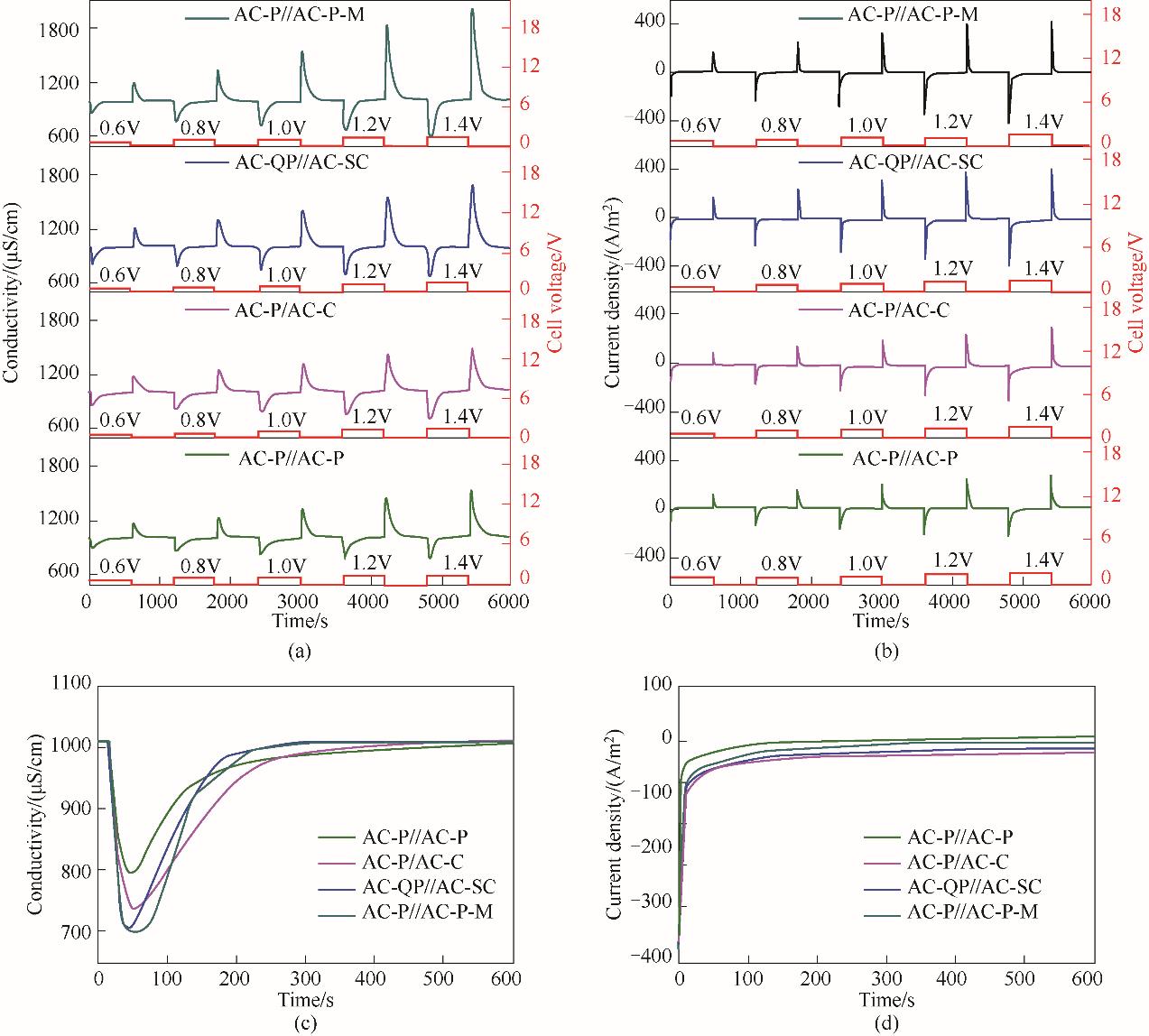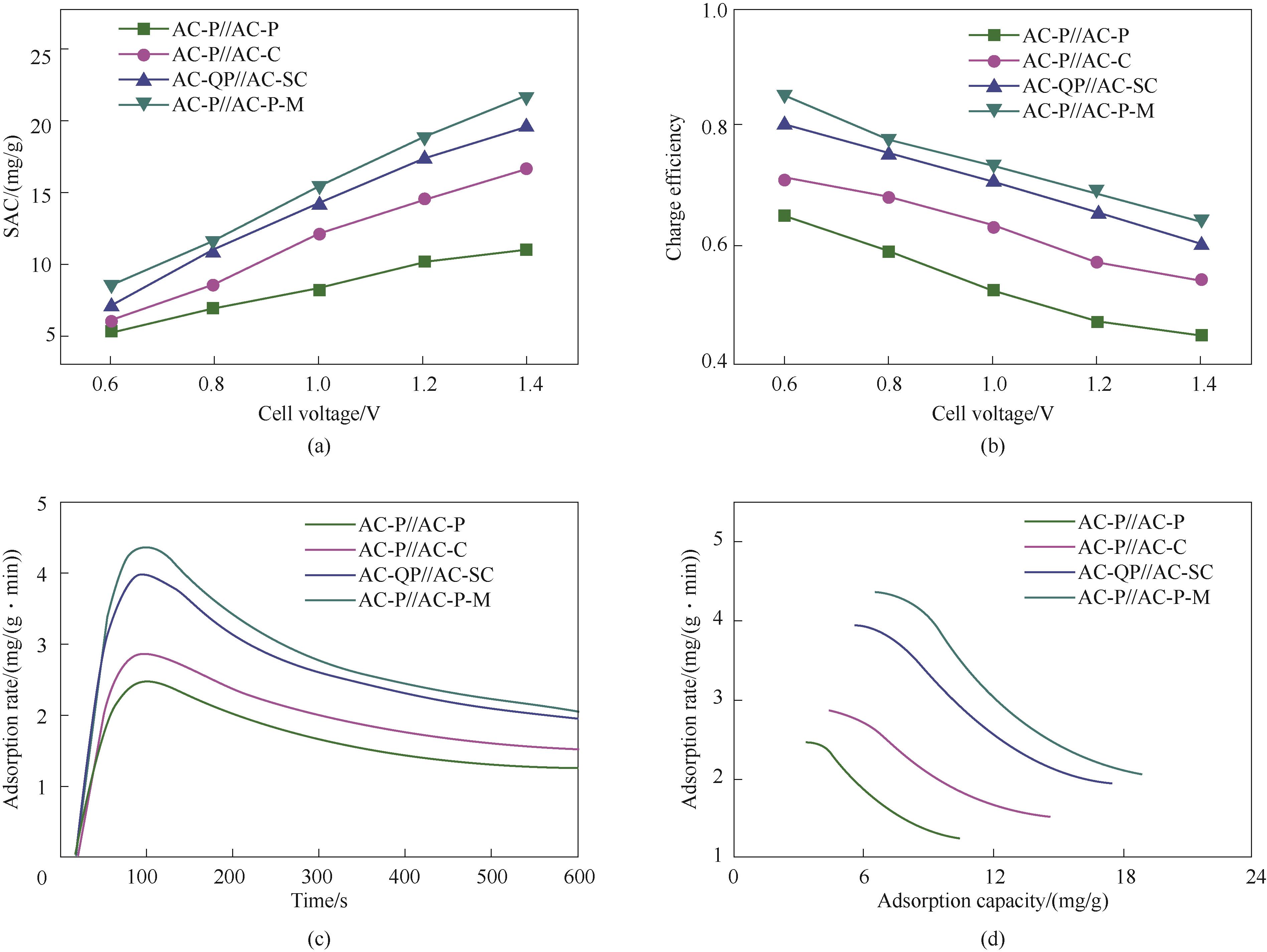CIESC Journal ›› 2022, Vol. 73 ›› Issue (4): 1763-1771.DOI: 10.11949/0438-1157.20211793
• Material science and engineering, nanotechnology • Previous Articles Next Articles
Gang WANG1,2( ),Xiaoping CHE2,Shiyong WANG1,Jieshan QIU2(
),Xiaoping CHE2,Shiyong WANG1,Jieshan QIU2( )
)
Received:2021-12-20
Revised:2022-01-26
Online:2022-04-25
Published:2022-04-05
Contact:
Jieshan QIU
通讯作者:
邱介山
作者简介:王刚(1979—),男,博士,教授,基金资助:CLC Number:
Gang WANG, Xiaoping CHE, Shiyong WANG, Jieshan QIU. Carbon electrodes modified with water-soluble charged polymer binder for enhanced capacitive deionization performance[J]. CIESC Journal, 2022, 73(4): 1763-1771.
王刚, 车小平, 汪仕勇, 邱介山. 水溶性带电聚合物黏结剂修饰炭电极用于增强电容去离子性能[J]. 化工学报, 2022, 73(4): 1763-1771.
Add to citation manager EndNote|Ris|BibTeX

Fig.5 The conductivity changes (a) and current density changes (b) of AC-P//AC-P, AC-P//AC-C, AC-QP//AC-SC and AC-P//AC-P-M at different cell voltages; The conductivity changes (c) and current density changes (d) of AC-P//AC-P, AC-P//AC-C, AC-QP//AC-SC and AC-P//AC-P-M under 1.2 V

Fig.6 SAC (a), charge passed (b), adsorption rate curves (c) and Ragone curves (d) of AC-P//AC-P, AC-P//AC-C, AC-QP//AC-SC, and AC-P//AC-P-M in NaCl solution with an initial concentration of 500 mg/L at different cell voltages
| 1 | Ou R, Zhang H, Truong V X, et al. A sunlight-responsive metal–organic framework system for sustainable water desalination [J]. Nature Sustainability, 2020, 3(12): 1052-1058. |
| 2 | Gamaethiralalage J G, Singh K, Sahin S, et al. Recent advances in ion selectivity with capacitive deionization[J]. Energy & Environmental Science, 2021, 14(3): 1095-1120. |
| 3 | Liu Y, Wang K, Xu X T, et al. Recent advances in faradic electrochemical deionization: system architectures versus electrode materials[J]. ACS Nano, 2021, 15(9): 13924-13942. |
| 4 | Li Q, Zheng Y, Xiao D J, et al. Faradaic electrodes open a new era for capacitive deionization[J]. Advanced Science, 2020, 7(22): 2002213. |
| 5 | Nam D H, Lumley M A, Choi K S. Electrochemical redox cells capable of desalination and energy storage: addressing challenges of the water-energy nexus[J]. ACS Energy Letters, 2021, 6(3): 1034-1044. |
| 6 | Zhang P H, Li J H, Chan-Park M B. Hierarchical porous carbon for high-performance capacitive desalination of brackish water[J]. ACS Sustainable Chemistry & Engineering, 2020, 8(25): 9291-9300. |
| 7 | Liu M Q, Xu M, Xue Y F, et al. Efficient capacitive deionization using natural basswood-derived, freestanding, hierarchically porous carbon electrodes[J]. ACS Applied Materials & Interfaces, 2018, 10(37): 31260-31270. |
| 8 | 王刚, 张云启, 汪仕勇, 等. 共价交联法制备具有优异电容去离子脱盐性能的硼碳氮纳米片/石墨烯复合电极[J]. 新型炭材料, 2020, 35(4): 384-393. |
| Wang G, Zhang Y Q, Wang S Y, et al. Boron-nitride-carbon nanosheet/graphene composites generated by covalent cross-linking which have an excellent capacitive deionization performance[J]. New Carbon Materials, 2020, 35(4): 384-393. | |
| 9 | Kalfa A, Shapira B, Shopin A, et al. Capacitive deionization for wastewater treatment: opportunities and challenges[J]. Chemosphere, 2020, 241: 125003. |
| 10 | Gong X Y, Luo W X, Guo N N, et al. Carbon nanofiber@ZIF-8 derived carbon nanosheet composites with a core–shell structure boosting capacitive deionization performance[J]. Journal of Materials Chemistry A, 2021, 9(34): 18604-18613. |
| 11 | Liu X H, Zhang S H, Feng G L, et al. Core-shell MOF@COF motif hybridization: selectively functionalized precursors for titanium dioxide nanoparticle-embedded nitrogen-rich carbon architectures with superior capacitive deionization performance[J]. Chemistry of Materials, 2021, 33(5): 1657-1666. |
| 12 | Jung Y, Yang Y, Kim T, et al. Enhanced electrochemical stability of a zwitterionic-polymer-functionalized electrode for capacitive deionization[J]. ACS Applied Materials & Interfaces, 2018, 10(7): 6207-6217. |
| 13 | Huo S L, Ni W, Zhao Y F, et al. Highly efficient atomically dispersed Co–N active sites in porous carbon for high-performance capacitive desalination of brackish water[J]. Journal of Materials Chemistry A, 2021, 9(5): 3066-3076. |
| 14 | Zhang J, Yan T T, Fang J H, et al. Enhanced capacitive deionization of saline water using N-doped rod-like porous carbon derived from dual-ligand metal–organic frameworks[J]. Environmental Science: Nano, 2020, 7(3): 926-937. |
| 15 | Ntakirutimana S, Tan W. Electrochemical capacitive behaviors of carbon/titania composite prepared by Tween 80-assisted sol-gel process for capacitive deionization[J]. Desalination, 2021, 512: 115131. |
| 16 | Peng W J, Wang W, Han G H, et al. Fabrication of 3D flower-like MoS2/graphene composite as high-performance electrode for capacitive deionization[J]. Desalination, 2020, 473: 114191. |
| 17 | Huo S L, Song X, Zhao Y B, et al. Insight into the significant contribution of intrinsic carbon defects for the high-performance capacitive desalination of brackish water[J]. Journal of Materials Chemistry A, 2020, 8(38): 19927-19937. |
| 18 | Kim M, Cerro M D, Hand S, et al. Enhancing capacitive deionization performance with charged structural polysaccharide electrode binders[J]. Water Research, 2019, 148: 388-397. |
| 19 | Xie J Z, Xue Y F, He M, et al. Organic-inorganic hybrid binder enhances capacitive deionization performance of activated-carbon electrode[J]. Carbon, 2017, 123: 574-582. |
| 20 | Weng J Z, Wang S Y, Wang G, et al. Carbon electrode with cross-linked and charged chitosan binder for enhanced capacitive deionization performance[J]. Desalination, 2021, 505: 114979. |
| 21 | Choi J Y, Choi J H. A carbon electrode fabricated using a poly(vinylidene fluoride) binder controlled the Faradaic reaction of carbon powder[J]. Journal of Industrial and Engineering Chemistry, 2010, 16(3): 401-405. |
| 22 | Asquith B M, Meier-Haack J, Ladewig B P. Poly(arylene ether sulfone) copolymers as binders for capacitive deionization activated carbon electrodes[J]. Chemical Engineering Research and Design, 2015, 104: 81-91. |
| 23 | Chai L L, Qu Q T, Zhang L F, et al. Chitosan, a new and environmental benign electrode binder for use with graphite anode in lithium-ion batteries[J]. Electrochimica Acta, 2013, 105: 378-383. |
| 24 | Yu T H, Shiu H Y, Lee M S, et al. Life cycle assessment of environmental impacts and energy demand for capacitive deionization technology[J]. Desalination, 2016, 399: 53-60. |
| 25 | Cao P F, Yang G, Li B R, et al. Rational design of a multifunctional binder for high-capacity silicon-based anodes[J]. ACS Energy Letters, 2019, 4(5): 1171-1180. |
| 26 | Chen C, Lee S H, Cho M, et al. Cross-linked chitosan as an efficient binder for Si anode of Li-ion batteries[J]. ACS Applied Materials & Interfaces, 2016, 8(4): 2658-2665. |
| 27 | Byles B W, Cullen D A, More K L, et al. Tunnel structured manganese oxide nanowires as redox active electrodes for hybrid capacitive deionization[J]. Nano Energy, 2018, 44: 476-488. |
| 28 | Xing W L, Liang J, Tang W W, et al. Versatile applications of capacitive deionization (CDI)-based technologies[J]. Desalination, 2020, 482: 114390. |
| 29 | Wang S Y, Wang G, Wu T T, et al. Membrane-free hybrid capacitive deionization system based on redox reaction for high-efficiency NaCl removal[J]. Environmental Science & Technology, 2019, 53(11): 6292-6301. |
| 30 | Ahualli S, Iglesias G R, Fernández M M, et al. Use of soft electrodes in capacitive deionization of solutions[J]. Environmental Science & Technology, 2017, 51(9): 5326-5333. |
| 31 | Kim Y J, Choi J H. Improvement of desalination efficiency in capacitive deionization using a carbon electrode coated with an ion-exchange polymer[J]. Water Research, 2010, 44(3): 990-996. |
| 32 | Kim Y J, Choi J H. Enhanced desalination efficiency in capacitive deionization with an ion-selective membrane[J]. Separation and Purification Technology, 2010, 71(1): 70-75. |
| 33 | Lee J Y, Seo S J, Yun S H, et al. Preparation of ion exchanger layered electrodes for advanced membrane capacitive deionization (MCDI)[J]. Water Research, 2011, 45(17): 5375-5380. |
| 34 | Park B H, Kim Y J, Park J S, et al. Capacitive deionization using a carbon electrode prepared with water-soluble poly(vinyl alcohol) binder[J]. Journal of Industrial and Engineering Chemistry, 2011, 17(4): 717-722. |
| 35 | Jain A, Kim J, Owoseni O M, et al. Aqueous-processed, high-capacity electrodes for membrane capacitive deionization[J]. Environmental Science & Technology, 2018, 52(10): 5859-5867. |
| [1] | Longyi LYU, Wenbo JI, Muda HAN, Weiguang LI, Wenfang GAO, Xiaoyang LIU, Li SUN, Pengfei WANG, Zhijun REN, Guangming ZHANG. Enhanced anaerobic removal of halogenated organic pollutants by iron-based conductive materials: research progress and future perspectives [J]. CIESC Journal, 2023, 74(8): 3193-3202. |
| [2] | Yuanhao QU, Wenyi DENG, Xiaodan XIE, Yaxin SU. Study on electro-osmotic dewatering of sludge assisted by activated carbon/graphite [J]. CIESC Journal, 2023, 74(7): 3038-3050. |
| [3] | Luyue HUANG, Chang LIU, Yongyi XU, Haoruo XING, Feng WANG, Shuangchen MA. Development of CDI two-dimensional concentration mass transfer model and experimental validation [J]. CIESC Journal, 2022, 73(7): 2933-2943. |
| [4] | Qi WANG, Kuo FANG, Conghui HE, Kaijun WANG. Recent development and future challenges of flow-electrode capacitive deionization [J]. CIESC Journal, 2022, 73(3): 975-989. |
| [5] | Li LIU, Peng JIANG, Wei WANG, Tonghuan ZHANG, Liwen MU, Xiaohua LU, Jiahua ZHU. Coupling process simulation and random forest model for analyzing and predicting biomass-to-hydrogen conversion [J]. CIESC Journal, 2022, 73(11): 5230-5239. |
| [6] | Chao ZHANG, Jian CHEN, Wenhua YIN, Yuanhui SHEN, Zhaoyang NIU, Xiuxin YU, Donghui ZHANG, Zhongli TANG. Transient analysis of pressure swing adsorption hydrogen purification process [J]. CIESC Journal, 2022, 73(1): 308-321. |
| [7] | LUO Weili, WANG Wenwen, PAN Quanwen, GE Tianshu, WANG Ruzhu. Heat storage performance of composite adsorbent with activated carbon fiber [J]. CIESC Journal, 2021, 72(S1): 554-559. |
| [8] | Kang YAN, Song YANG, Shoujun LIU, Chao YANG, Huiling FAN, Ju SHANGGUAN. In-situ preparation of ZnO-based activated carbon desulfurizer from low-rank coal [J]. CIESC Journal, 2021, 72(9): 4921-4930. |
| [9] | LIU Yizheng, SHI Bin, RAN Ling, TANG Jun, TAN Siping, LIU Jiangtao, ZHANG Peng, ZHAO Jinbao. Research progress of molten salt electrolyte and separator materials for thermal batteries [J]. CIESC Journal, 2021, 72(7): 3524-3537. |
| [10] | JIAO Shuai, YANG Lei, WU Tingting, LI Hongqiang, LYU Huihong, HE Xiaojun. Synthesis of nitrogen doped hierarchically porous carbon nanosheets for supercapacitor by mixed salt template [J]. CIESC Journal, 2021, 72(5): 2869-2877. |
| [11] | WANG Jing, HAN Qiaoning, LEI Yiting, TANG Man, CHEN Lihong, CHE Junda, LIU Zuguang. One-step preparation of oxygen-enriched lignin activated carbon and its methylene blue adsorption performance [J]. CIESC Journal, 2021, 72(5): 2826-2836. |
| [12] | JIANG Wenwen, NIE Pengfei, HU Bin, LI Jingjing, LIU Jianyun. Selective capacitive adsorption of fluoride ions with Al2O3/AC anode [J]. CIESC Journal, 2021, 72(5): 2817-2825. |
| [13] | ZHOU Ye, XIAO Huixia, WANG Yifei, YU Guangsuo. Study on improving slurryability of lignite based on coal blending and surface modification [J]. CIESC Journal, 2021, 72(4): 2233-2240. |
| [14] | HE Pengpeng, ZHAO Song, MAO Chenyue, WANG Zhi, WANG Jixiao. Research progress of solvent-resistant composite nanofiltration membrane [J]. CIESC Journal, 2021, 72(2): 727-747. |
| [15] | CAO Jianing, GAO Xiang, LUO Yingwu, SU Rongxin. Study on preparation and performance of aqueous binder for lithium iron phosphate electrodes in lithium-ion battery [J]. CIESC Journal, 2021, 72(2): 1169-1180. |
| Viewed | ||||||
|
Full text |
|
|||||
|
Abstract |
|
|||||